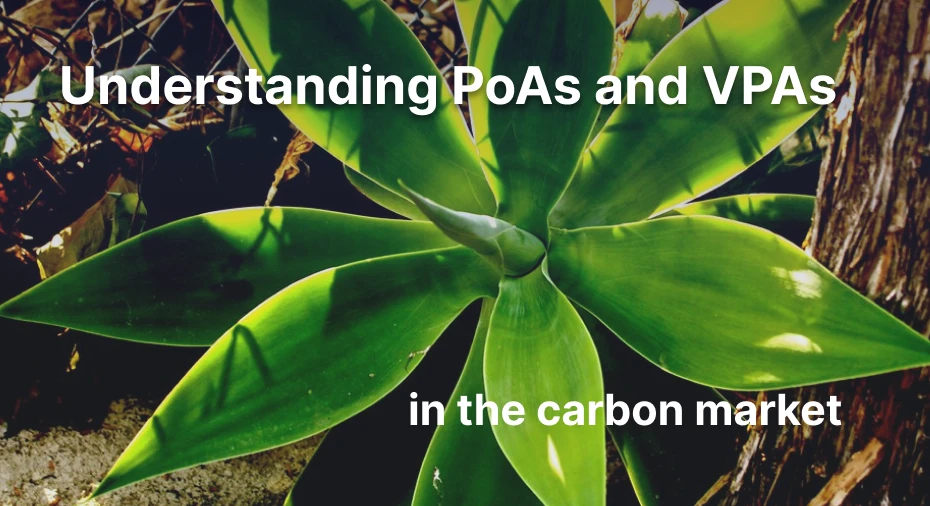
What are PoAs & VPAs
Carbon projects can sometimes be bundled under a “Programme of Activities” (PoA). A “Programme of Activities” (PoA) is a set of related activities, called Voluntary Project Activities (VPAs), with a common objective and implementation approach. PoAs (sometimes called “parents”) were designed to provide efficiency by allowing multiple VPAs (the “children”) under them to be organized under a coordinating or managing arrangement that reduces administrative costs and enables smaller-scale activities that might not otherwise be able to participate in a carbon crediting program.
PoAs and VPAs are typical of the Gold Standard (GS), while the Clean Development Mechanism (CDM) has developed PoAs and CPAs (Component Project Activity). The Verified Carbon Standard (VCS) combines multiple project activities as “grouped projects”. All are similar approaches that allow projects to scale up over time while reducing costs.
Under the Gold Standard, each VPA has a unique project ID. All VPAs must meet the PoA´s eligibility criteria. Sometimes VPAs are very similar. Other times the VPAs may differ substantially – sometimes they may even be implemented in different countries – and therefore may have different risks or SDG impacts per VPA. To account for the diversity of VPAs, Calyx Global assesses each VPA within a PoA. In assessing the individual VPAs, Calyx Global considers both the documentation of the Programme of Activities and the VPA, in order to ensure the rating is accurate.
Sometimes, however, there are no differences among VPAs. This may occur because there are benefits to deploying numerous VPAs under the GS Simplified methodology beyond the typical benefits of deploying VPAs under a PoA. For example, the GS Simplified methodology, as compared to GS TPDDTEC (another GS methodology that can be applied for cookstove projects and that larger projects must use), does not require kitchen performance tests (KPT) to determine project emissions reductions or the tracking of leakage. Instead, GS Simplified projects are able to use water boil tests (WTB) from the manufacturer and apply an annual discount for stove efficiency and emission reductions and apply a 5% discount of leakage. This is an example of differences between methodologies, where choosing to “slice and dice” into VPAs relieves demands on the project, but in this case would increase the likelihood of overestimation in emission reductions and leakage.
PoA Examples
In the case of GS 1729 PoA Myanmar Stoves Campaign - Soneva in Myanmar, the Calyx Global GHG integrity rating is the same for all VPAs under this PoA, which we confirmed after checking each VPA. By contrast, under GS 1988 PoA Proyecto Mirador Improved Cookstoves in Latin America, the three VPAs are in different countries and have different characteristics. Therefore each has a different and unique rating.
GS PoAs also report on their SDG contributions. Similarly to the GHG process, the SDG team reviews the monitoring and verification reports generated under each VPA. In some cases, the quality of SDG reporting is similar across VPAs, however, we have also noted differences. For instance, in PoAs that are developed over several countries, the VPAs can substantially differ in terms of their reported SDG contributions. For example, the VPAs under GS 1988 have different overall Calyx SDG ratings.
In the case of GS 1729 - PoA Myanmar Stoves Campaign - Soneva in Myanmar, 17 micro-scale VPAs have been developed. We have conducted an SDG assessment of 12 out of 17 VPAs (VPA004, VPA006, VPA007, VPA008, and VPA010 to VPA017) and noted some differences:
- VPA004, and VPA014 to VPA017 do not report contributions to SDG 8 - Decent Work and Economic Growth (employment and training of local FES cookstoves vendors).
- VPA004 has not yet transitioned to the Global Standard for Global Goals (GS4GG); however, we assessed its SDG contributions based on the GS v 2.0 documentation.
- VPA001 and VPA002 are labeled by GS as deactivated projects.
- VPA003, VPA0005 and VPA009 do not yet have verification reports available in the GS registry.
- VPA009 requested a deviation that was issued and approved, demanding a different approach to MRV in light of COVID events and the 2021 Myanmar military coup, which resulted in movement restrictions, thereby limiting monitoring and verification capacity for these projects.
As one can see, it is important to look at each VPA (or CPA). Due to potential differences, one cannot assume that the “children” of PoAs will all be the same – which is not too dissimilar from the differences of real-life siblings! We hope this information is helpful in demystifying PoAs and VPAs (and also CPAs), which can be quite a confusing acronym soup to untangle.
Get the latest delivered to your inbox
Sign up to our newsletter for the Calyx News and Insights updates.
